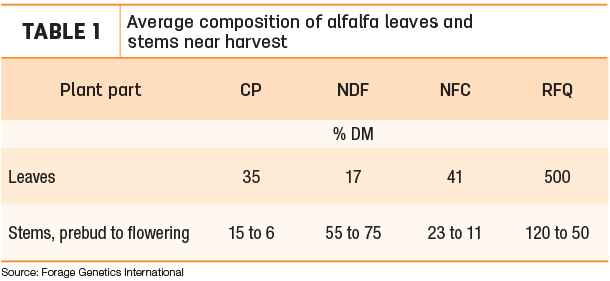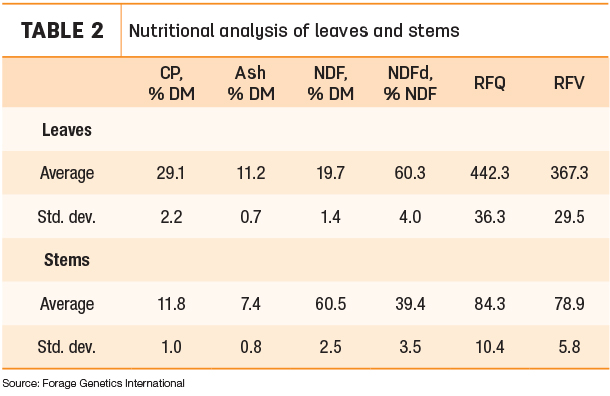The standard for alfalfa is evolving, and so is the way we evaluate it. At the 2021 World Dairy Expo, David Weakley, director of forage nutrition research for Forage Genetics International, unveiled the new Leaves Enhance Alfalfa Forage (LEAF) test now available to growers.
Filling the gap
Leaf loss is a major factor that can negatively impact harvested alfalfa forage quality. According to Weakley, 71% of variation in forage quality is due to the percentage of leaves found in the forage after harvest. Leaves have a relative forage quality (RFQ) of about 550, while stems have an RFQ of 70 to 80. This drastic difference accounts for the loss of RFQ when the ratio of stems to leaves in harvested forage favors the stems more than the leaves.
Weakley insists that growers must know the percent of leaves in their alfalfa to manage growing and harvesting their alfalfa to maintain a high RFQ.
Table 1 shows the difference in composition between stems and leaves that accounts for the major difference in RFQ.

In order to aid producers in reducing the variation in RFQ in their harvested forage and help determine a more accurate nutrient content of the forage, FGI has developed a multiple-variable prediction equation that can be used to calculate the percentage of leaves.
Development of the equation
Three different sets of samples were used to help develop the equation.
The main analysis of leaves and stems to develop the equation was done at the FGI research station in West Salem, Wisconsin, in the summer of 2021. Twelve varieties were cut at 28, 33 and 38 days for a total of 36 samples. Each sample was at least 100 grams and was dried down at a temperature of less than 140ºF. Once dried, the samples were hand separated into leaf and stem fractions.
The samples were weighed to collect a dry weight of both the leaf and the stem fractions, and the samples were ground. Each fraction was analyzed for dry matter (DM), ash, protein, and neutral detergent fiber (NDF) and NDFd28 (part of the Calibrate High Quality Forage Analysis Test) at the FGI Digestibility Lab. Table 2 breaks down the nutritional analysis of the leaves and stems samples.

During the summer of 2019, 160 samples were collected from the FGI research stations at West Salem, Wisconsin; Nampa, Idaho; and Davis, California. These samples consisted of 43 alfalfa varieties, three different cuttings and four different cutting schedules. The same guidelines were used to dry and separate the samples. The nutrient values were compared to the percent of leaves in a stepwise regression analysis to develop a “best fit” prediction equation. NDF, crude protein (CP), NDFd and ash were all considered significant terms in the prediction equation, but ash contributed very little for percent leaves and was dropped from the equation. The resulting prediction equation explained 84% of the variation in the leaf equation between the 160 samples.
Forty different samples were collected during the summer of 2020 in West Salem, Wisconsin and Davis, California. The same protocol was followed in drying and separating the leaves, and the nutrient values were then entered in the 2019 percent leaf prediction equation and compared with the measured leaf percent.
Validation of results
The standard percent of error was 2.8, meaning the leaf prediction equation can be “off” by an average of only 2.86 percentage units of leaves on a given sample. The 40 main analysis samples were then added to the original 160 samples and a new prediction equation, LEAF, was developed. The equation predicts percent leaves in alfalfa from NDF, protein and NDFd28 measured in a ground sample of alfalfa.
How to access LEAF test
Producers can submit an alfalfa sample for the LEAF test to any licensed lab for the Calibrate HQ analysis. This currently includes: SureTech Labs, Dairyland Labs, Cumberland Valley, Rock River Labs and Dairy One.









